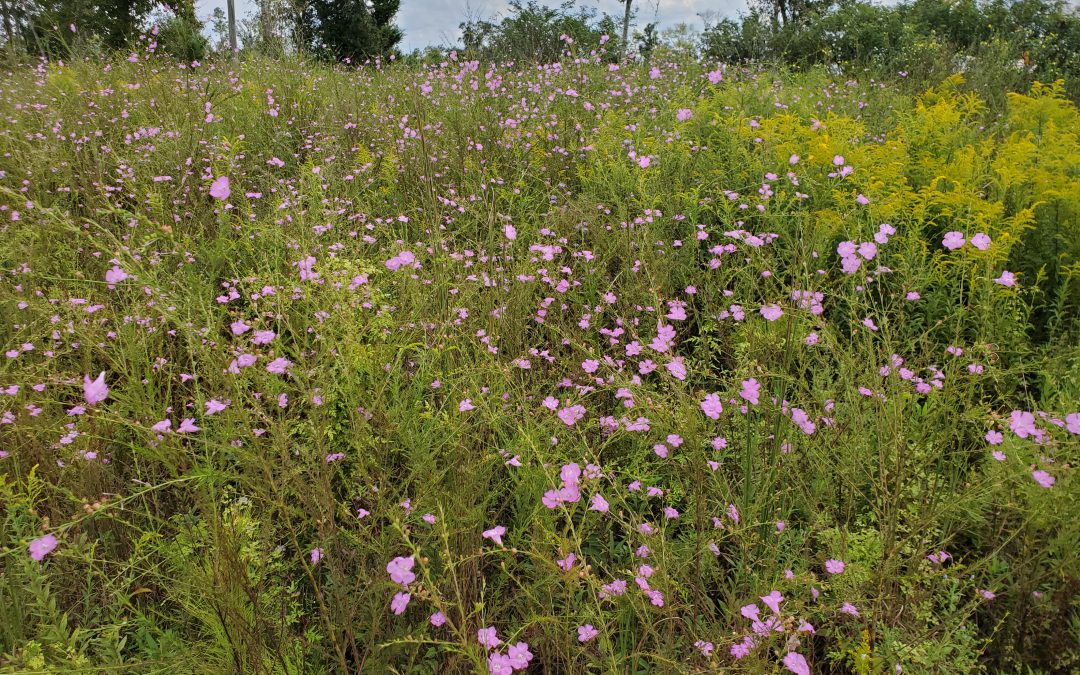
by Daniel J. Leonard | Sep 30, 2021
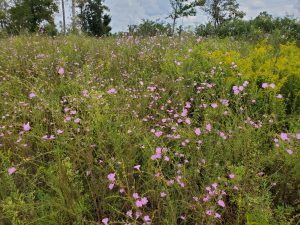
False Foxglove in a Calhoun County natural area. Photo courtesy of Daniel Leonard.
Fall is the absolute best season for wildflower watching in the Panhandle! When mid-September rolls around and the long days of summer finally shorten, giving way to drier air and cooler nights, northwest Florida experiences a wildflower color explosion. From the brilliant yellow of Swamp Sunflower and Goldenrod, to the soothing blue of Mistflower, and the white-on-gold of Spanish Needles, there is no shortage of sights to see from now until frost. But, in my opinion, the star of the fall show is the currently flowering False Foxglove (Agalinus spp.).
Named for the appearance of their brilliant pink flowers, which bear a resemblance to the northern favorite Foxglove (Digitalis spp.), “False Foxglove” is actually the common name of several closely related species of parasitic plants in the genus Agalinus that are difficult to distinguish by all but the keenest of botanists. Regardless of which species you may see, False Foxglove is an unusual and important Florida native plant. Emerging from seed each spring in the Panhandle, plants grow quickly through the summer to a mature height of 3-5’. During this time, False Foxglove is about as inconspicuous a plant as grows. Consisting of a wispy thin woody stem with very small, narrow leaves, plants remain hidden in the flatwoods and sand hill landscapes that they inhabit. However, when those aforementioned shorter September days arrive, False Foxglove explodes into flower sporting sprays of dozens of light purple to pink tubular-shaped flowers that remain until frost ends the season.
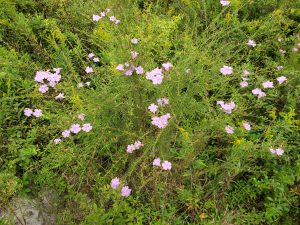
False Foxglove flowering in a Calhoun County natural area. Photo courtesy of Daniel Leonard.
In addition to being unmatched in flower, False Foxglove also plays several important ecological roles in Florida’s natural areas. First, False Foxglove’s relatively large, tubular-shaped flowers are the preferred nectar sources for the larger-sized native solitary and bumble bees present in the Panhandle, though all manner of generalist bees and butterflies will also visit for a quick sip. Second, False Foxglove is the primary host plant for the unique Common Buckeye butterfly. One of the most easily recognizable butterflies due to the large “eye” spots on their wings, Common Buckeye larvae (caterpillars), feed on False Foxglove foliage during the summer before emerging as adults and adding to the fall spectacle. Finally, False Foxglove is an important indicator of a healthy native ecosystem. As a parasitic plant, False Foxglove obtains nutrients and energy by photosynthesis AND by using specialized roots to tap into the roots of nearby suitable hosts (native grasses and other plants). As both False Foxglove and its parasitic host plants prefer to grow in the sunny, fire-exposed pine flatwoods and sand ridges that characterized pre-settlement Florida, you can be fairly confident that if you see a natural area with an abundance of False Foxglove in flower, that spot is in good ecological shape!
The Florida Panhandle is nearly unmatched in its fall wildflower diversity and False Foxglove plays a critical part in the show. From its stunning flowers to its important ecological roles, one would be hard-pressed to find a more unique native wildflower! For more information about False Foxglove and other Florida native wildflowers, contact your local UF/IFAS County Extension office.
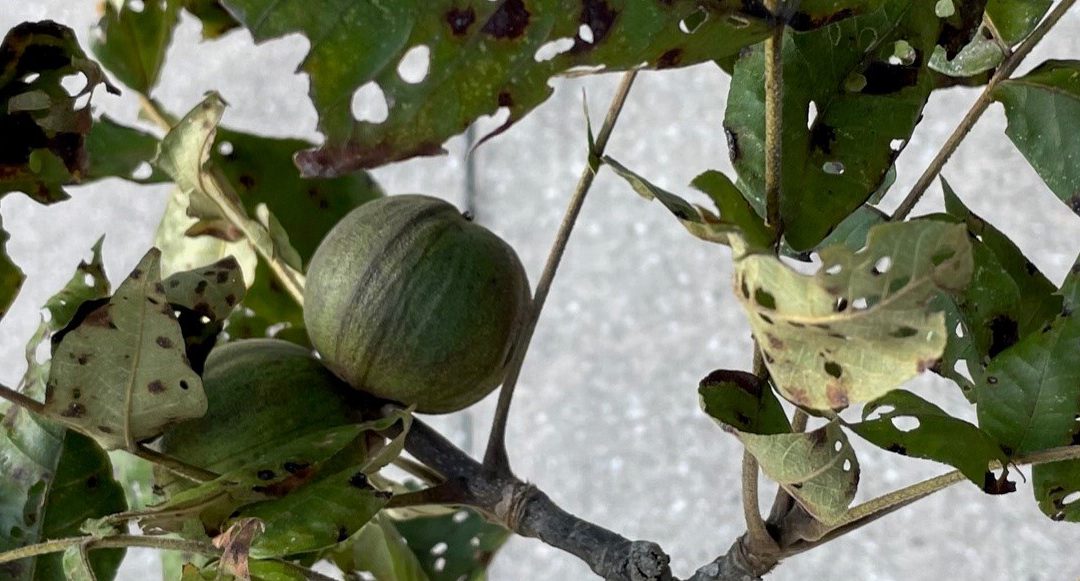
by Pat Williams | Sep 9, 2021
As homeowners, we do value our trees and no one wants to lose a shade tree especially on the house’s south side in Florida. On a recent site visit, a hickory tree had multiple concerns. Upon closer inspection, the tree had a bacterial infection about 30” off the ground with a smelly, black-brown ooze seeping forth. The leaf canopy was riddled with beetle holes and leaf margins were chewed by caterpillars. When leaves were viewed under the microscope, thrips (insects) and spider mites were found running around. The biggest homeowner cosmetic concern arose from hickory anthracnose (fungus) and upon closer inspection found the leaves to have hickory midge fly galls. The obvious question is should the tree come down? I’ll have you read the whole article before giving you the answer.
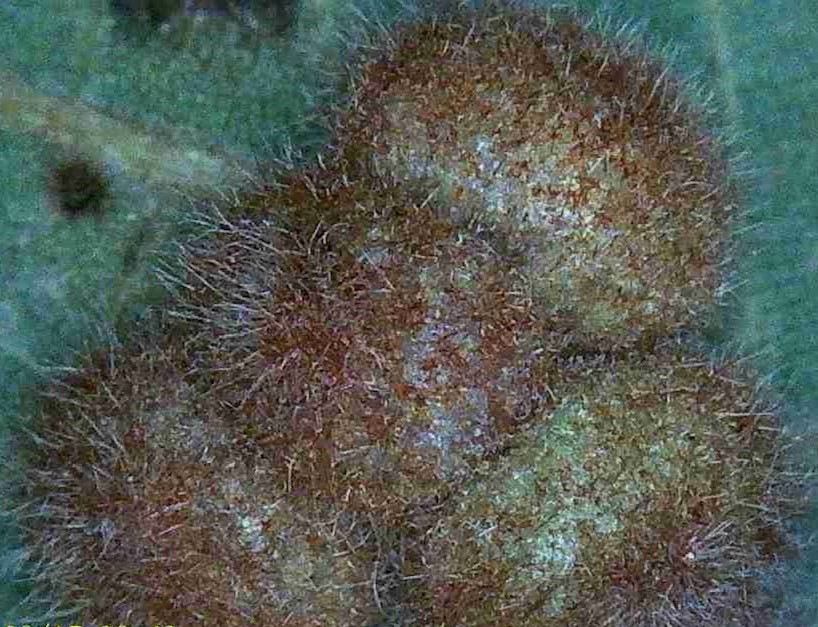
Each hickory gall is approximately 3/16″ wide.
Hickory anthracnose or leaf spot as seen in the banner photo is caused by a fungal infection during the wet summer months in Florida. The homeowner can usually recognize the disease by the large reddish brown spots on the upper leaf surface (sending a sample to the NFREC Plant Pathology Lab will confirm the diagnosis) and brownish spots with no formal shape on the bottom. Be sure to rake and remove all leaves to prevent your disease from overwintering close to the tree thus reducing infection next year.
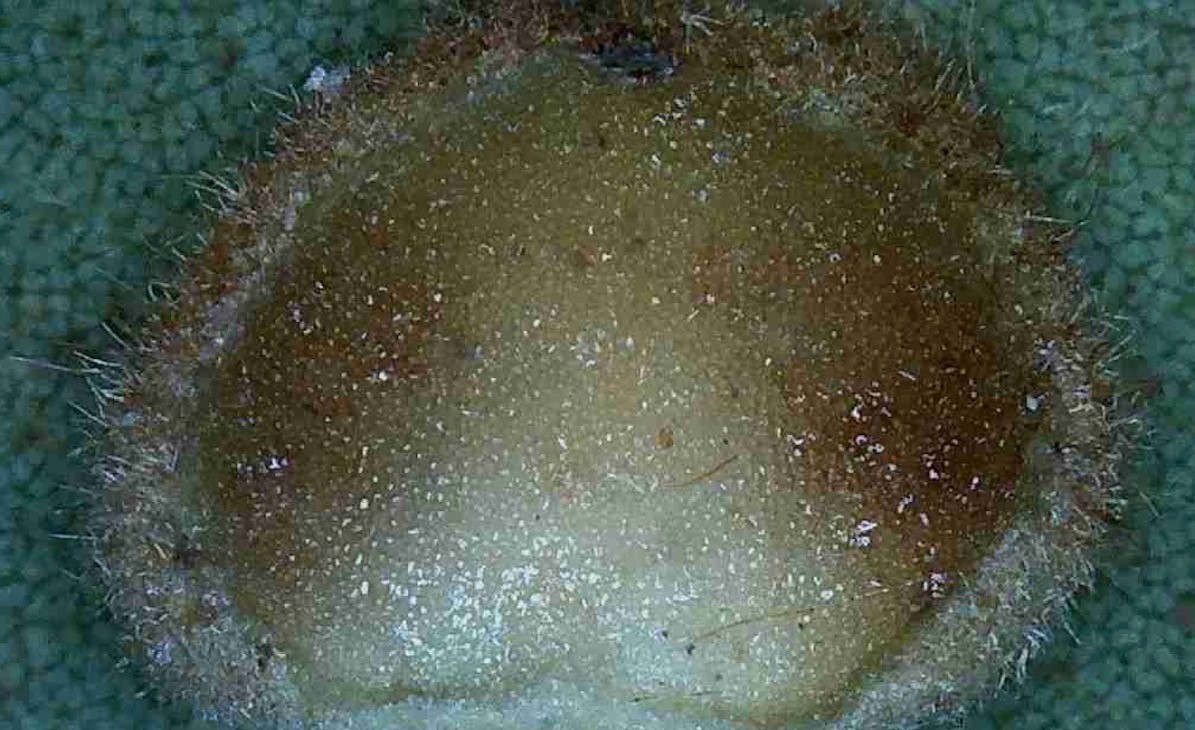
A hickory gall has been cut in half to show the leaf tissue.
The fungus can be lessened by good cultural practices and appropriate fungicidal applications. Please remember it is best left to professionals when spraying a large tree. This alone is not cause to remove your tree.
Hickory gall is caused by the hickory midge fly, an insect that lays eggs in the leaf tissue. The plant responds by building up tissue around each egg almost like the oyster when forming a pearl.
As the gall tissue grows, eggs hatch and larva start to feed on this tissue. The larva will continue to
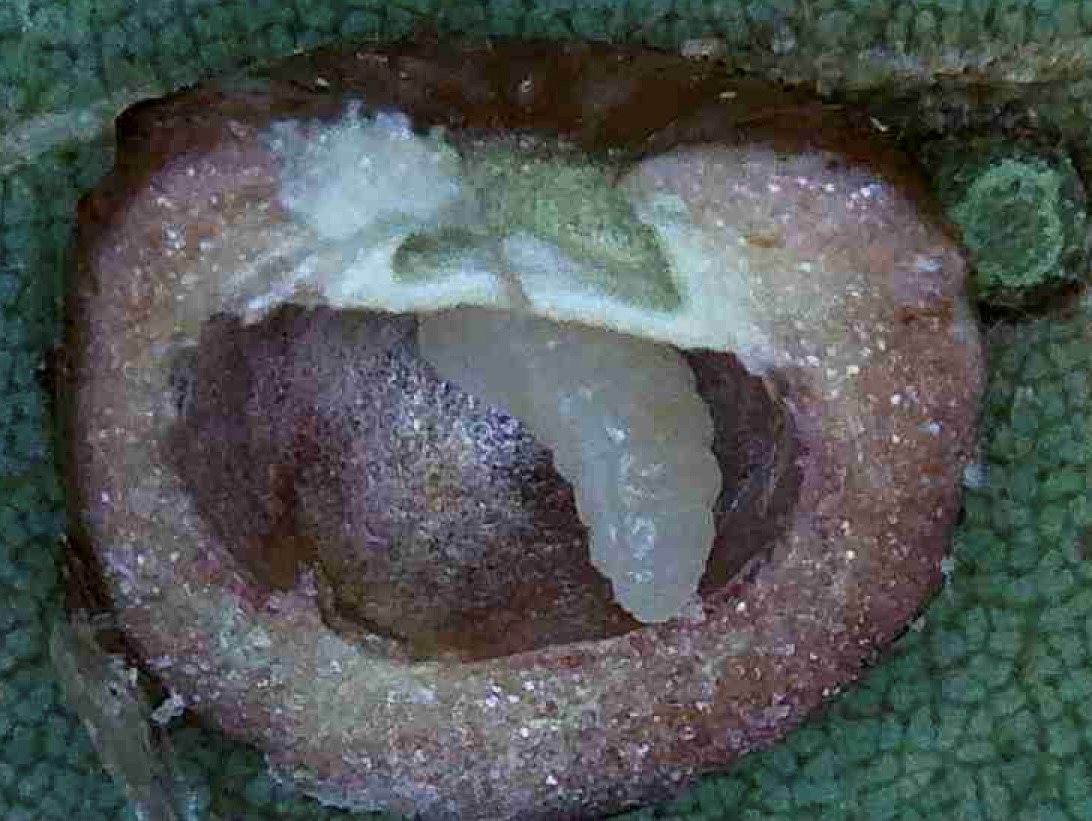
The larva has eaten all soft material inside the gall and is ready to pupate.
feed until it is ready to pupate within the gall. After forming a pupa, the midge fly will eventually emerge as an adult and females will continue to lay eggs on other leaves. The galls are more of a cosmetic damage and because your hickory leaves will fall from the tree as winter comes, the galls will normally not cause enough damage to worry about each year. Once again good cultural practices and disposal of each year’s leaves will reduce the gall numbers next year.
In a large tree with many leaves, foliar feeding by beetles and caterpillars do cause damage though the leaves will still produce enough food (photosynthesis) to keep the tree alive. Most of us never climb our trees to look at leaves to see the small insects/mites and there are more than enough leaves to maintain tree health.
The biggest concern during my site visit was their tree’s bacterial infection. A knife blade was pushed into the wound area and went in less than 1/4″. The homeowner was instructed to look at bactericide applications. In the end, this hickory tree with so many problems is still shading the home and helping cool the house. It is still giving refuge to wildlife and beneficial insects. When in doubt give our trees the benefit and keep them in place. Remember your local Extension agent is set up to make site visits and saving a tree is time well spent.
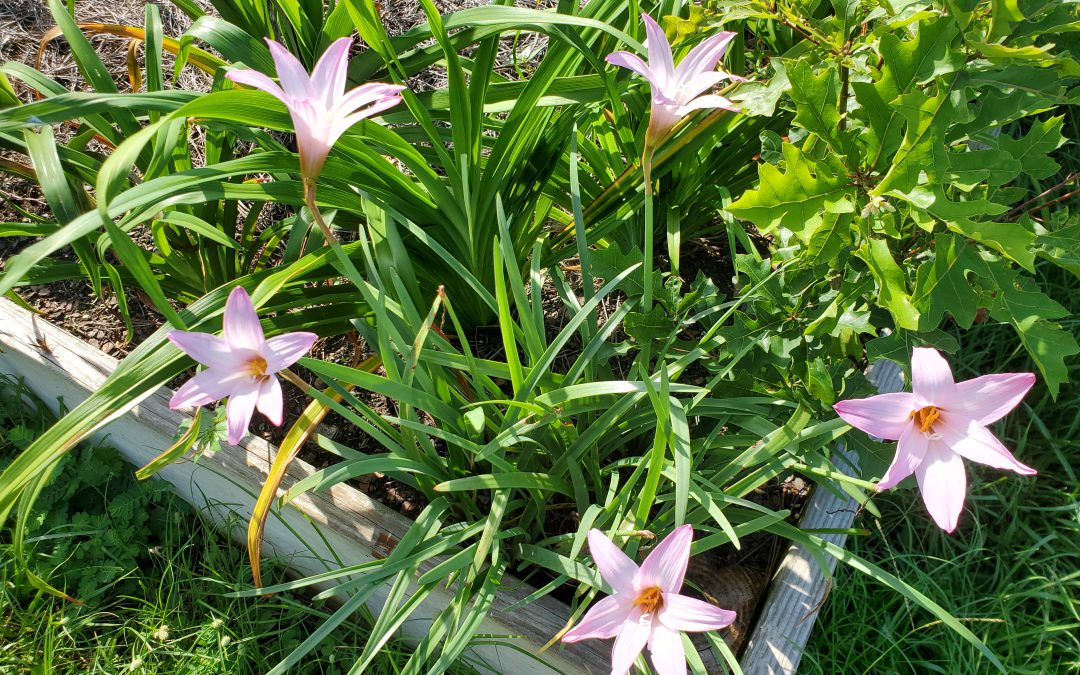
by Daniel J. Leonard | Sep 9, 2021
Bulbs are my favorite class of ornamental plants. They generally are low maintenance, come back reliably year after year, and sport the showiest flowers around. While many bulbs like Daylily, Crinum and Amaryllis are very common in Panhandle landscapes, there is a lesser-known genus of bulbs that is well worth your time and garden space, the Rainlily (Zephyranthes spp.).
Rainlily, aptly named for its habit of blooming shortly after summer rainfall events and a member of the Amaryllis family of bulbs, is a perfect little plant for Panhandle yards for several reasons. The plant’s genus name, Zephyranthes – which translates to English as “flowers of the western winds”, hints at the beauty awaiting those who plant this lovely little bulb. From late spring until the frosts of fall, Rainlily rewards gardeners with flushes of trumpet-shaped flowers in shades of white, pink, and yellow, with some hybrids offering even more exotic colors. While these individual flowers typically only persist for a day or two, they are produced in “flushes” that last several days, extending the show. Though Rainlily flowers are the main event for the genus, beneath the blooms, plants also offer attractive, grass-like, evergreen foliage. These aesthetic attributes lend themselves to Rainlily being used in a variety of ways in landscapes, from massing for summer color ala Daylilies, to use around the edges of beds as a showy border like Liriope or other “border” type grassy plants.
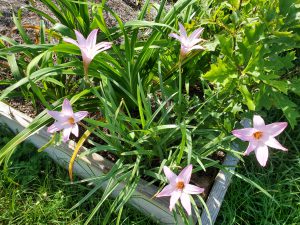
Unknown Rainlily species blooming in a raised bed. Photo courtesy of Daniel Leonard.
Continuing along the list of Rainlily attributes, the genus doesn’t require much in the way of care from gardeners either. Most species of Rainlily, including the Florida native Z. atamasca, have no serious pests and are right at home in full sun to part shade. Once established, plants are exceedingly low-maintenance and won’t require any supplemental irrigation or fertilizer! Some Rainlily species like Z. candida even make excellent water or ditch garden plants, preferring to have their feet wet most of the year – putting them right at home in the Panhandle this year. And finally, all Zephyranthes spp. do very well in containers and raised beds also, adding versatility to their use in your landscape!
The one drawback of Rainlily is that they can be somewhat difficult to find for sale. As these bulbs are an uncommon sight in most garden centers, to source a specific Zephyranthes species or cultivar, one is probably going to need to purchase from a specialty internet or mail-order nursery. As with other passalong-type bulbs though, the absolute best and most rewarding way to obtain Rainlily is to get a dormant season bulb division from a friend or fellow gardener who grows them. There are many excellent unnamed or forgotten Zephyranthes cultivars and seedlings flourishing in gardens across the South, waiting to be passed around to the next generation of folks who will appreciate them!
Even if you must go to some lengths to get a Rainlily in your garden, I highly recommend doing so! You’ll be rewarded with years of low-maintenance summer color after the dreariest of rainy days and will be able to pass these “flowers of the western wind” on to the next gardening generation. For more information on growing, sourcing, or propagating Rainlilies, check out this EDIS publication by Dr. Gary Knox of the UF/IFAS North Florida Research and Education Center (NFREC) or contact your local UF/IFAS Extension office! Happy Gardening!
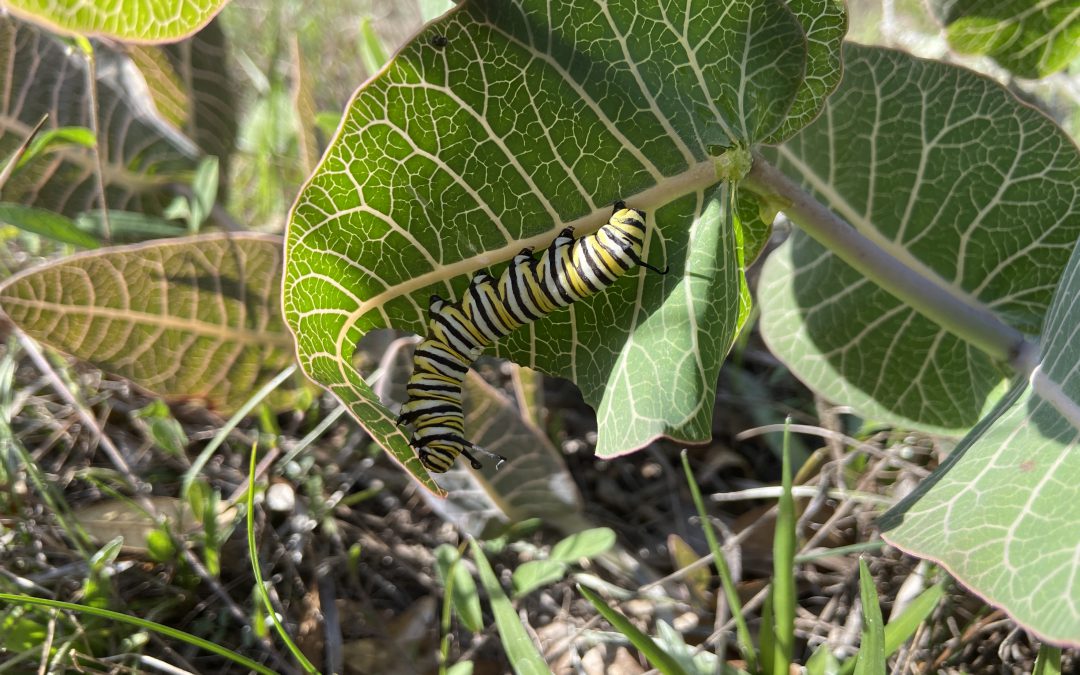
by Mary Salinas | Aug 20, 2021
On August 12, 2021, our panel answered questions on a wide variety of landscape topics. Maybe you are asking the same questions, so read on!
Ideas on choosing plants
What are some perennials that can be planted this late in the summer but will still bloom through the cooler months into fall?
Duranta erecta ‘Sapphire Showers’ or ‘Gold Mound’, firespike, Senna bicapsularis, shrimp plant, lion’s ear
Where can native plants be obtained?
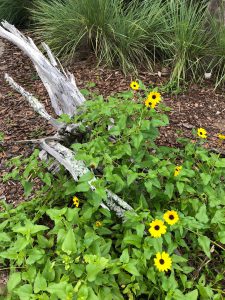
Dune sunflower, Helianthus debilis. Photo credit: Mary Salinas UF/IFAS Extension.
Gardening Solutions: Florida Native Plants – see link to FANN: https://gardeningsolutions.ifas.ufl.edu/plants/ornamentals/native-plants.html
What are some evergreen groundcover options for our area?
Mondo grass, Japanese plum yew, shore juniper, ajuga, ferns such as autumn fern.
What are some ideas for partial morning sun butterfly attracting tall flowers to plant now?
Milkweed, salt and pepper plant, swamp sunflower, dune sunflower, ironweed, porterweed, and salt bush.
I’m interested in moving away from a monoculture lawn. What are some suggestions for alternatives?
Perennial peanut, powderpuff mimosa, and frogfruit.
We are new to Florida and have questions about everything in our landscape.
Florida-Friendly-Landscaping TM Program and FFL Web Apps: https://ffl.ifas.ufl.edu/
https://ffl.ifas.ufl.edu/resources/apps/
UF IFAS Gardening Solutions: https://gardeningsolutions.ifas.ufl.edu/
What are some of the top trends in landscaping today?
Houseplants, edible gardens, native plants, food forests, attracting wildlife, container gardening, and zoysiagrass lawns
Edibles
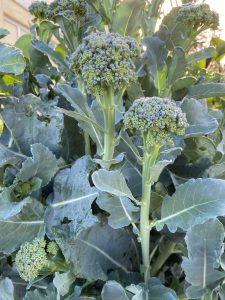
Artwork broccoli is a variety that produces small heads. Photo credit: Mary Salinas UF/IFAS Extension.
What vegetables are suitable for fall/winter gardening?
Cool Season Vegetables: https://gardeningsolutions.ifas.ufl.edu/plants/edibles/vegetables/cool-season-vegetables.html
North Florida Gardening Calendar: https://edis.ifas.ufl.edu/publication/EP451%20%20%20
Florida Vegetable Gardening Guide: https://edis.ifas.ufl.edu/publication/vh021
How can I add herbs to my landscape?
Herbs in the Florida Garden: https://gardeningsolutions.ifas.ufl.edu/plants/edibles/vegetables/herbs.html
My figs are green and hard. When do they ripen?
Why Won’t My Figs Ripen: https://www.lsuagcenter.com/profiles/rbogren/articles/page1597952870939
What is best soil for raised bed vegetable gardens?
Gardening in Raised Beds: https://edis.ifas.ufl.edu/publication/EP472
And there are always questions about weeds
How can I eradicate cogongrass?
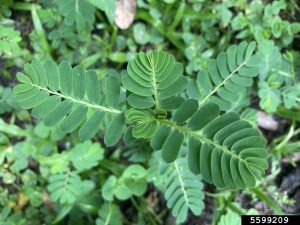
Chamber bitter is a troublesome warm season weed in our region. Photo credit: Brantlee Spakes Richter, University of Florida, Bugwood.org
Cogongrass: https://edis.ifas.ufl.edu/publication/WG202
Is it okay to use cardboard for weed control?
The Cardboard Controversy: https://gardenprofessors.com/the-cardboard-controversy/
What is the best way to control weeds in grass and landscape beds?
Weed Management Guide for Florida Lawns: https://edis.ifas.ufl.edu/publication/EP141
Improving Weed Control in Landscape Planting Beds: https://edis.ifas.ufl.edu/pdf/EP/EP52300.pdf
Landscape practices
Can ground water be brackish and stunt plants?
Reclaimed Water Use in the Landscape: https://edis.ifas.ufl.edu/publication/ss545
How can I prevent erosion from rainwater runoff?
Stormwater Runoff Control – NRCS: https://www.nrcs.usda.gov/wps/portal/nrcs/detail/national/water/?cid=nrcs144p2_027171
Rain Gardens: https://gardeningsolutions.ifas.ufl.edu/design/types-of-gardens/rain-gardens.html
And https://gardeningsolutions.ifas.ufl.edu/pdf/articles/rain-garden-manual-hillsborough.pdf
What is the best time of the year to propagate flowering trees in zone 8B?
Landscape Plant Propagation Information Page – UF/IFAS Env. Hort: https://hort.ifas.ufl.edu/database/lppi/
Which type of mulch works best on slopes greater than 3 percent?
Landscape Mulches: How Quickly do they Settle?: https://edis.ifas.ufl.edu/publication/FR052
When should bulbs be fertilized?
Bulbs and More – UI Extension: https://web.extension.illinois.edu/bulbs/planting.cfm
Should I cut the spent blooms of agapanthus?
Agapanthus, extending the bloom time: https://gardeningsolutions.ifas.ufl.edu/plants/ornamentals/agapanthus.html
http://blogs.ifas.ufl.edu/wakullaco/2020/10/07/extending-bloom-time/
Plant questions
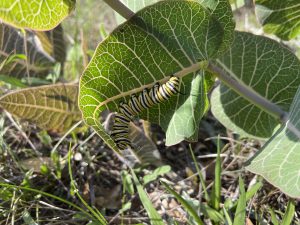
Monarch caterpillar munching on our native sandhill milkweed, Asclepias humistrata. Photo credit: Mary Salinas, UF IFAS Extension.
I planted native milkweed and have many monarch caterpillars. Should I protect them or leave them in nature?
It’s best to leave them in place. Featured Creatures: Monarch Butterfly: https://edis.ifas.ufl.edu/pdf/IN/IN780/IN780-Dxyup8sjiv.pdf
How does Vinca (periwinkle) do in direct sun? Will it make it through one of our panhandle summers? Can I plant in late August?
Periwinkles and No more fail with Cora series: https://gardeningsolutions.ifas.ufl.edu/plants/ornamentals/periwinkles.html#:~:text=Plant%20your%20periwinkles%20where%20they,rot%20if%20irrigated%20too%20frequently.
Insect and disease pests
What to do if you get termites in your raised bed?
The Facts About Termites and Mulch: https://edis.ifas.ufl.edu/publication/IN651
How to combat fungus?
Guidelines for ID and Management of Plant Disease Problems: https://edis.ifas.ufl.edu/publication/mg442
Are there preventative measures to prevent diseases when the humidity is very high and it is hot?
Fungi in Your Landscape by Maxine Hunter: http://blogs.ifas.ufl.edu/marionco/2020/01/16/fungi-in-your-landscape/
If you missed an episode, check out our playlist on YouTube https://www.youtube.com/watch?v=bp0HfdEkIQw&list=PLhgoAzWbtRXImdFE8Jdt0jsAOd-XldNCd
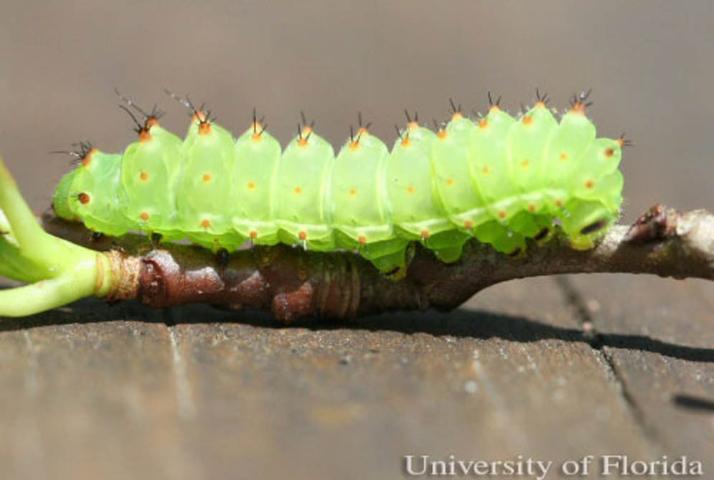
by Carrie Stevenson | Aug 5, 2021
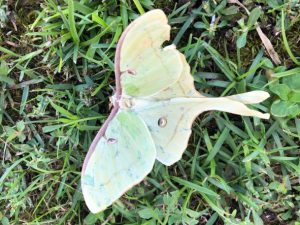
The moon-like eyespots and long tails on its wings are identifying features of the luna moth. Photo credit: Carrie Stevenson, UF IFAS Extension
We hear about butterflies all the time–their beautiful wing patterns, how to plant entire gardens for them, and the fascinating migration patterns of monarchs. But if you look around, you might just find their night-dwelling cousins, the moths, have some pretty incredible traits, too.
I find luna moths (Actias luna) just as interesting as many of the colorful butterflies native to our area. Luna moths are considerably larger than the little brown and black moths you see fluttering around streetlights. Their wingspan can be up to 4” wide, with long, tapering tails trailing behind them. The moth is native to the entire eastern portion of the United States, but has a longer life span the further south it resides. Luna moths live year-round in Florida, with up to three generations (trivoltine) born annually. They are pale green, and adults have a furry white underbelly. Lunas are so eye-catching that they have been featured on the cover of a field guide to moths, postage stamps from the United States and other countries, and as the mascot of the insomnia medication, Lunesta.
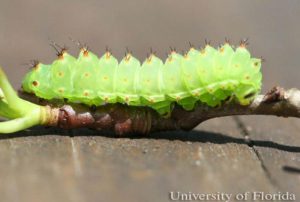
The caterpillar of the luna moth is bright green and warns off predators by making an intimidating clicking sound. Photo credit: University of Florida
Luna moths have several celestial ties in their name. All the moths in its larger family, Saturnidae, have round eyespots (which fool would-be predators) composed of concentric circles like the rings of Saturn. “Luna” comes from the Latin for moon, after the moon-colored eyespots on its back.
Luna moth caterpillars are fat and green—the classic caterpillar—and about 2.5” long. Their preferred host plants in the south are typically sweet gum, hickory, walnut, and persimmon trees. Interestingly, the caterpillars can make a sound, typically described as a clicking noise. Biologists believe this noise-making is a defense mechanism, performed as a precursor to spitting up unpleasant fluids to fend off predators. Several studies have shown that the twisting motion of the adult luna moth’s long tails in flight can interrupt the echolocation of bats, helping the moths evade predation.
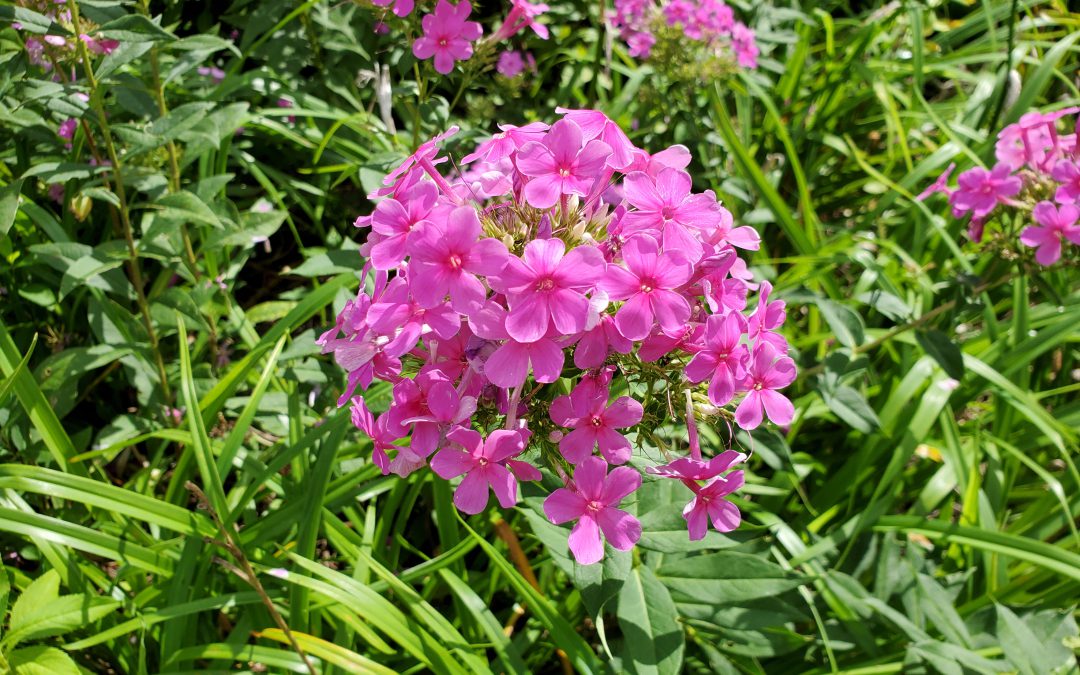
by Daniel J. Leonard | Aug 5, 2021
The number one request all would-be gardeners and budding landscape enthusiasts have is “I want something that I don’t have to take care of, tolerates the heat, blooms, and comes back every year”. That is a tall order in our climate but not an impossible one, especially if one is willing to take a step back in time and consider an old Southern passalong plant, Garden Phlox (Phlox paniculata)!

Garden Phlox (Phlox paniculata) in a Calhoun County landscape. Photo courtesy of Daniel Leonard.
This old heirloom perennial is an outstanding ornamental for Panhandle landscapes. Every spring, Garden Phlox emerges from a long winter sleep and shoots its attractive bright green foliage straight up, reaching 3-5’ in height. After hiding inconspicuously in the landscape all spring, Phlox then blasts into fiery magenta bloom during the heat of summer, beginning the show in late June. While individual Phlox flowers are only 1” wide or so, they are held prominently above the plant’s foliage in large clusters up to 8” in diameter and are about as eye-catching as flowers come. The flower show continues through July and August until finally fading out as fall rolls around. Plants then set seed and ready themselves for winter dormancy, repeating the cycle the following spring. A bonus, though individual Phlox plantings start off as small, solitary clumps, they slowly expand over the years, never over-aggressively or unwanted, into a mass of color that becomes the focal point of any landscape they occupy!
In addition to being gorgeous, Phlox is adaptable and demands very little from gardeners. The species prefers to be sited in full, blazing sun but can also handle partial shade. Just remember, the more shade Phlox is in, the fewer flowers it will produce. Site accordingly. Phlox is also extremely drought tolerant, thriving in most any semi-fertile well-drained soil. Though it can handle drought like a champ, Phlox will languish if planted in a frequently damp location. If water stands on the planting site for more than an hour or so after a big rain event, it is most likely too wet for Phlox to thrive. Once established, Phlox is not a heavy feeder either. A light application of a general-purpose fertilizer after spring emergence from winter dormancy will sustain the plants’ growth and flowering all summer long!
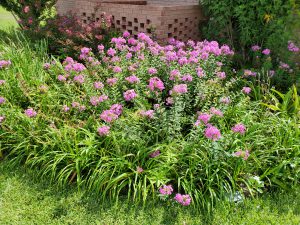
Clump of Garden Phlox in a Calhoun County landscape. Photo courtesy of Daniel Leonard.
Though the ornamental and low-maintenance attributes of plain Garden Phlox make it sound like a perfect landscape plant, it is uncommon in the modern nursery trade, having fallen out of favor as many old plants often do. The species is still a familiar site around old home places, cemeteries, abandoned buildings, and the like throughout the South, but is difficult to find in most commercial nurseries. The primary reason for this is that the commercially available modern Phlox hybrids sporting exotic flower colors and shapes are not tolerant of our growing conditions. These new Garden Phlox hybrids were bred to perform in the milder conditions of more norther climes and are extremely susceptible to the many fungal diseases brought on by Florida’s heat and humidity of summer, particularly Powdery Mildew. It’s best to avoid these newcomers and stick to the old variety with its pink flowers and ironclad constitution. Plain old Garden Phlox can be found in some independent and native plant nurseries, but the best and most rewarding method of acquisition is to make friends with someone that already has a clump and dig up a piece of theirs!
If you have been looking for a low-maintenance, high impact perennial to add to your landscape, old-fashioned Garden Phlox might be just the plant for you! For more information on Garden Phlox, other landscape perennials, passalong plants or any other horticultural topic, contact your local UF/IFAS County Extension Office. Happy Gardening!




















